key Ram 2500 2017 Owners Manual
[x] Cancel search | Manufacturer: RAM, Model Year: 2017, Model line: 2500, Model: Ram 2500 2017Pages: 734, PDF Size: 7.3 MB
Page 462 of 734

•Mud – Deep mud creates a great deal of suction around
the tires and is very difficult to get through. You should
use 4LO (Low Range) with a gear low enough to
maintain your momentum without shifting. If you start
to slow to a stop, try turning your steering wheel no
more than a ¼ turn quickly back and forth for additional
traction. Mud holes pose an increased threat of vehicle
damage and getting stuck. They are normally full of
debris from previous vehicles getting stuck. As a good
practice before entering any mud hole, get out and
determine how deep it is, if there are any hidden
obstacles and if the vehicle can be safely recovered if
stuck.
• Sand – Soft sand is very difficult to travel through with
full tire pressure. When crossing soft sandy spots in a
trail maintain your vehicle’s momentum and do not
stop. The key to driving in soft sand using the appro-
priate tire pressure, accelerating slowly, avoiding abrupt
maneuvers and maintaining the vehicle’s momentum. If
you are going to be driving on large soft sandy areas or
dunes, reduce your tire pressure to a minimum of 15 psi
(103 kPa) to allow for a greater tire surface area. Reduced
tire pressure will drastically improve your traction and
handling, while driving on the soft sand, but you must
return the tires to normal air pressure before driving on pavement or other hard surfaces. Be sure you have a
way to air the tires back up prior to reducing the
pressure.
CAUTION!
Reduced tire pressures may cause tire unseating and
total loss of air pressure. To reduce the risk of tire
unseating, while at a reduced tire pressure, reduce your
speed and avoid sharp turns or abrupt maneuvers.
Crossing Obstacles (Rocks And Other High Points)
While driving off road, you will encounter many types of
terrain. These varying types of terrain bring different types
of obstacles. Before proceeding review the path ahead to
determine the correct approach and your ability to safely
recover the vehicle if something goes wrong. Keeping a
firm grip on the steering wheel, bring the vehicle to a
complete stop and then inch the vehicle forward until it
makes contact with the object. Apply the throttle lightly
while holding a light brake pressure and ease the vehicle
up and over the object.
460 STARTING AND OPERATING
Page 463 of 734

WARNING!
Crossing obstacles can cause abrupt steering system
loading which could cause you to loose control of your
vehicle.
Using A Spotter
There are many times where it is hard to see the obstacle or
determine the correct path. Determining the correct path
can be extremely difficult when you are confronting many
obstacles. In these cases have someone guide you over,
through, or around the obstacle. Have the person stand a
safe distance in front of you where they can see the
obstacle, watch your tires and undercarriage, and guide
you through.
Crossing Large Rocks
When approaching large rocks, choose a path which en-
sures you drive over the largest with your tires. This will
lift your undercarriage over the obstacle. The tread of the
tire is tougher and thicker than the side wall and is
designed to take the abuse. Always look ahead and make
every effort to cross the large rocks with your tires.
CAUTION!
•Never attempt to straddle a rock that is large enough
to strike your axles or undercarriage.
• Never attempt to drive over a rock which is large
enough to contact the door sills.
Crossing A Ravine, Gully, Ditch, Washout Or Rut
When crossing a ravine, gully, ditch, washout or a large rut,
the angled approach is the key to maintaining your vehi-
cle’s mobility. Approach these obstacles at a 45-degree
angle and let each tire go through the obstacle indepen-
dently. You need to use caution when crossing large
obstacles with steep sides. Do not attempt to cross any
large obstacle with steep sides at an angle great enough to
put the vehicle at risk of a rollover. If you get caught in a
rut, dig a small trench to the right or left at a 45-degree
angle ahead of the front tires. Use the removed dirt to fill
the rut ahead of the turnout you just created. You should
now be able to drive out following the trench you just
created at a 45-degree angle.
5
STARTING AND OPERATING 461
Page 467 of 734
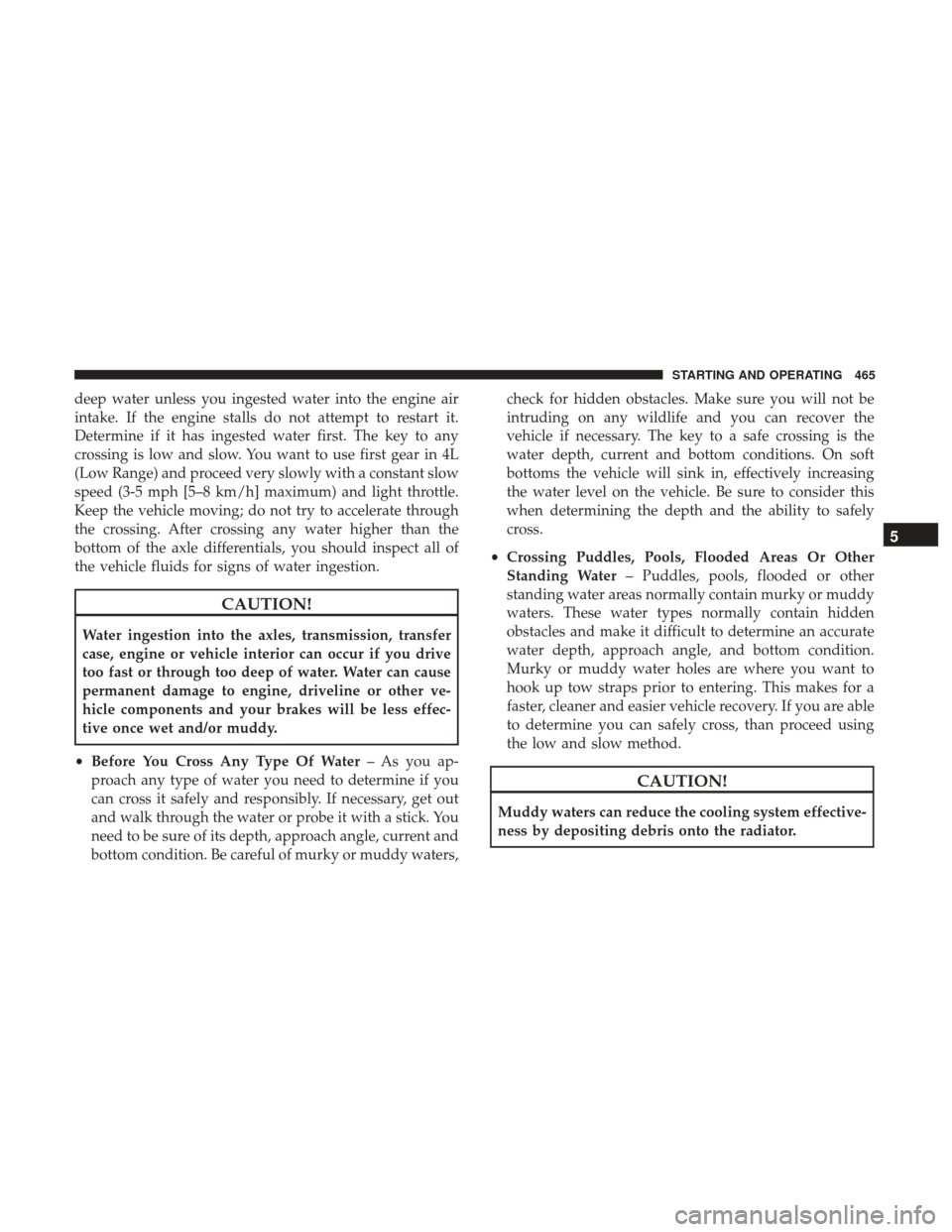
deep water unless you ingested water into the engine air
intake. If the engine stalls do not attempt to restart it.
Determine if it has ingested water first. The key to any
crossing is low and slow. You want to use first gear in 4L
(Low Range) and proceed very slowly with a constant slow
speed (3-5 mph [5–8 km/h] maximum) and light throttle.
Keep the vehicle moving; do not try to accelerate through
the crossing. After crossing any water higher than the
bottom of the axle differentials, you should inspect all of
the vehicle fluids for signs of water ingestion.
CAUTION!
Water ingestion into the axles, transmission, transfer
case, engine or vehicle interior can occur if you drive
too fast or through too deep of water. Water can cause
permanent damage to engine, driveline or other ve-
hicle components and your brakes will be less effec-
tive once wet and/or muddy.
• Before You Cross Any Type Of Water – As you ap-
proach any type of water you need to determine if you
can cross it safely and responsibly. If necessary, get out
and walk through the water or probe it with a stick. You
need to be sure of its depth, approach angle, current and
bottom condition. Be careful of murky or muddy waters, check for hidden obstacles. Make sure you will not be
intruding on any wildlife and you can recover the
vehicle if necessary. The key to a safe crossing is the
water depth, current and bottom conditions. On soft
bottoms the vehicle will sink in, effectively increasing
the water level on the vehicle. Be sure to consider this
when determining the depth and the ability to safely
cross.
• Crossing Puddles, Pools, Flooded Areas Or Other
Standing Water – Puddles, pools, flooded or other
standing water areas normally contain murky or muddy
waters. These water types normally contain hidden
obstacles and make it difficult to determine an accurate
water depth, approach angle, and bottom condition.
Murky or muddy water holes are where you want to
hook up tow straps prior to entering. This makes for a
faster, cleaner and easier vehicle recovery. If you are able
to determine you can safely cross, than proceed using
the low and slow method.
CAUTION!
Muddy waters can reduce the cooling system effective-
ness by depositing debris onto the radiator.
5
STARTING AND OPERATING 465
Page 482 of 734

General Information
Practice using your winch before you get stuck. Some key
points to remember when using your winch are:
•Always take your time to assess the situation and plan
your pull carefully.
• Always take your time when using a winch.
• Use the right equipment for the situation.
• Always wear leather gloves and do not allow the wire
rope to slip through your hands when handling the
rope.
• Only the operator should handle the wire rope and
remote control.
• Think safety at all times.
Vehicle Recovery Using The Winch
CAUTION!
•Always Know Your Winch: Take the time to fully
read and understand the included Installation and
Operations Guide, and Basic Guide to Winching
Techniques, in order to understand your winch and
the winching operation.
• Always inspect winch installation and wire rope
condition before operating the winch. Frayed,
kinked or damaged wire rope must be replaced
immediately. Loose or damaged winch installation
must be corrected immediately.
• Always be sure any element which can interfere with
safe winching operations is removed prior to initiat-
ing winching.
• Always keep remote control lead clear of the drum,
wire rope and rigging.
• Inspect for cracks, pinches, frayed wires, or loose
connections. Replace if damaged.
• Be careful not to pull the Winch Cable Collar
through the rollers. Watch and listen to Winch for
proper snugness.
480 STARTING AND OPERATING
Page 496 of 734
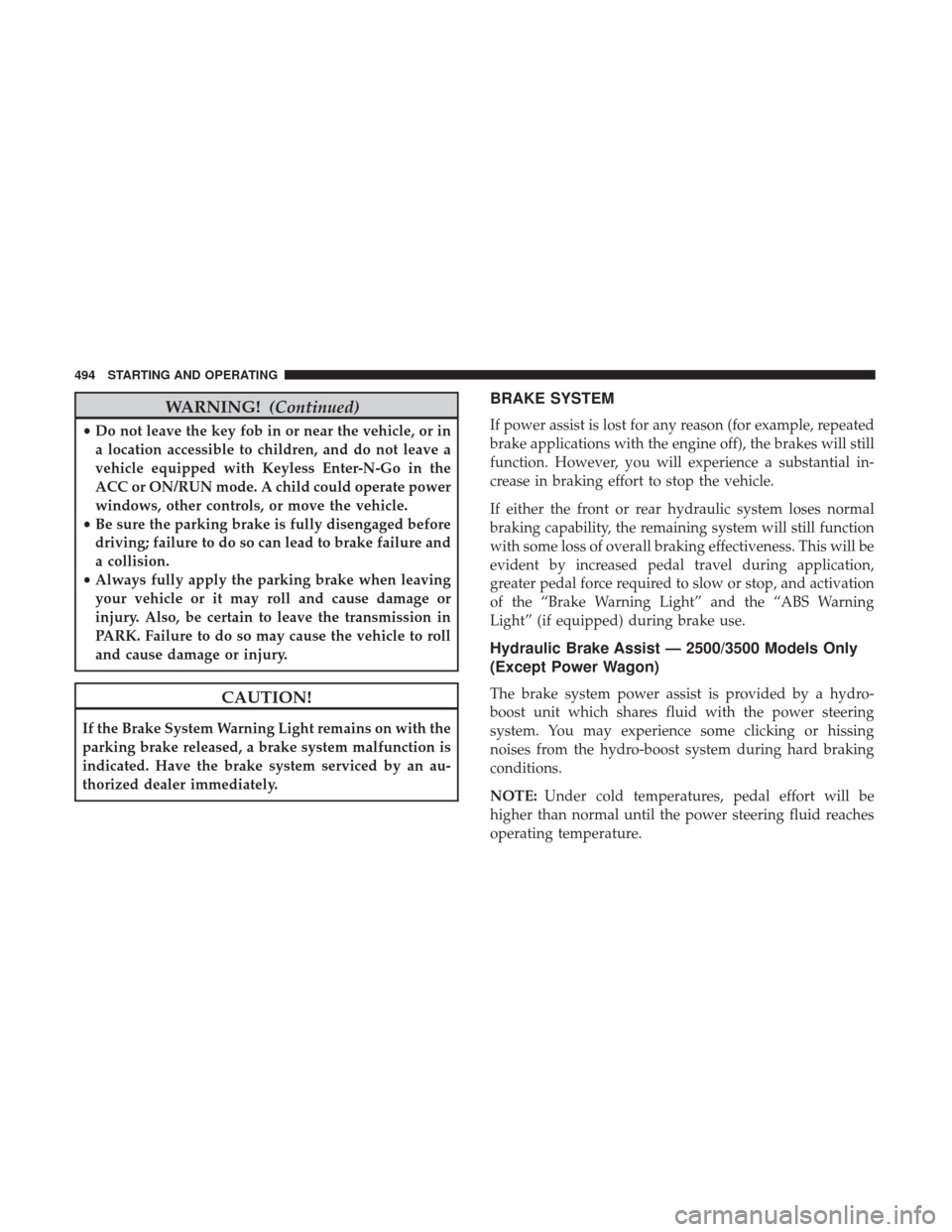
WARNING!(Continued)
•Do not leave the key fob in or near the vehicle, or in
a location accessible to children, and do not leave a
vehicle equipped with Keyless Enter-N-Go in the
ACC or ON/RUN mode. A child could operate power
windows, other controls, or move the vehicle.
• Be sure the parking brake is fully disengaged before
driving; failure to do so can lead to brake failure and
a collision.
• Always fully apply the parking brake when leaving
your vehicle or it may roll and cause damage or
injury. Also, be certain to leave the transmission in
PARK. Failure to do so may cause the vehicle to roll
and cause damage or injury.
CAUTION!
If the Brake System Warning Light remains on with the
parking brake released, a brake system malfunction is
indicated. Have the brake system serviced by an au-
thorized dealer immediately.
BRAKE SYSTEM
If power assist is lost for any reason (for example, repeated
brake applications with the engine off), the brakes will still
function. However, you will experience a substantial in-
crease in braking effort to stop the vehicle.
If either the front or rear hydraulic system loses normal
braking capability, the remaining system will still function
with some loss of overall braking effectiveness. This will be
evident by increased pedal travel during application,
greater pedal force required to slow or stop, and activation
of the “Brake Warning Light” and the “ABS Warning
Light” (if equipped) during brake use.
Hydraulic Brake Assist — 2500/3500 Models Only
(Except Power Wagon)
The brake system power assist is provided by a hydro-
boost unit which shares fluid with the power steering
system. You may experience some clicking or hissing
noises from the hydro-boost system during hard braking
conditions.
NOTE: Under cold temperatures, pedal effort will be
higher than normal until the power steering fluid reaches
operating temperature.
494 STARTING AND OPERATING
Page 575 of 734

Recreational Towing — Two-Wheel Drive Models
DO NOT flat tow this vehicle. Damage to the drivetrain
will result.
Recreational towing (for two-wheel drive models) is al-
lowedONLY if the rear wheels are OFFthe ground. This
may be accomplished using a tow dolly or vehicle trailer. If
using a tow dolly, follow this procedure:
NOTE: If vehicle is equipped with air suspension, ensure
the vehicle is set to Normal Ride Height.
1. Properly secure the dolly to the tow vehicle, following the dolly manufacturer’s instructions.
2. Drive the rear wheels onto the tow dolly.
3. Firmly apply the parking brake. Place automatic trans- mission in PARK, manual transmission in gear (not in
NEUTRAL).
4. Properly secure the rear wheels to the dolly, following the dolly manufacturer’s instructions.
5. Turn the ignition OFF and remove the key fob.
6. Install a suitable clamping device, designed for towing, to secure the front wheels in the straight position.
CAUTION!
•Towing with the rear wheels on the ground will
cause severe transmission damage. Damage from
improper towing is not covered under the New
Vehicle Limited Warranty.
•
Do not disconnect the driveshaft because fluid may
leak from the transmission, causing damage to internal
parts.
Recreational Towing — Four-Wheel Drive Models
NOTE: Both the manual shift and electronic shift transfer
cases must be shifted into NEUTRAL (N) for recreational
towing. Automatic transmissions must be shifted into
PARK for recreational towing. Manual transmissions must
be placed in gear (NOT in NEUTRAL) for recreational
towing. Refer to the following for the proper transfer case
NEUTRAL (N) shifting procedure for your vehicle.
5
STARTING AND OPERATING 573
Page 577 of 734

CAUTION!
It is necessary to follow these steps to be certain that
the transfer case is fully in NEUTRAL (N) before
recreational towing to prevent damage to internal
parts.
1. Bring the vehicle to a complete stop, with the engine running. Firmly apply the parking brake.
2. Shift the transmission to NEUTRAL.
NOTE: If vehicle is equipped with air suspension, ensure
the vehicle is set to Normal Ride Height.
3. Press and hold the brake pedal.
4. Depress the clutch pedal on a manual transmission.
5. With manual shift transfer case, shift the transfer case lever into NEUTRAL (N).
• With electronic shift transfer case, push and hold the
transfer case NEUTRAL (N) button. Some models
have a small, recessed “N” button (at the center of the
transfer case switches) that must be pushed using a
ballpoint pen or similar object. Other models have a
rectangular NEUTRAL switch, below the rotary trans-
fer case control knob. The NEUTRAL (N) indicator light will blink while the shift is in progress. The light
will stop blinking (stay on solid) when the shift to
NEUTRAL (N) is complete. After the shift is completed
and the NEUTRAL (N) light stays on, release the
NEUTRAL (N) button.
6. Release the parking brake.
7. Shift the transmission into REVERSE.
8. Release the brake pedal (and clutch pedal on manual transmissions) for five seconds and ensure that there is
no vehicle movement.
9. Repeat steps 7 and 8 with automatic transmission in DRIVE or manual transmission in first gear.
10. Shift the transmission to NEUTRAL. Firmly apply the parking brake. Turn OFF the engine. For vehicles with
Keyless Enter-N-Go, push and hold the ENGINE
START/STOP button until the engine shuts off.
11. Shift the transmission into PARK or place manual transmission in gear (NOT in Neutral). On 8-speed
transmissions the shifter will automatically select
PARK when the engine is turned off.
5
STARTING AND OPERATING 575
Page 578 of 734
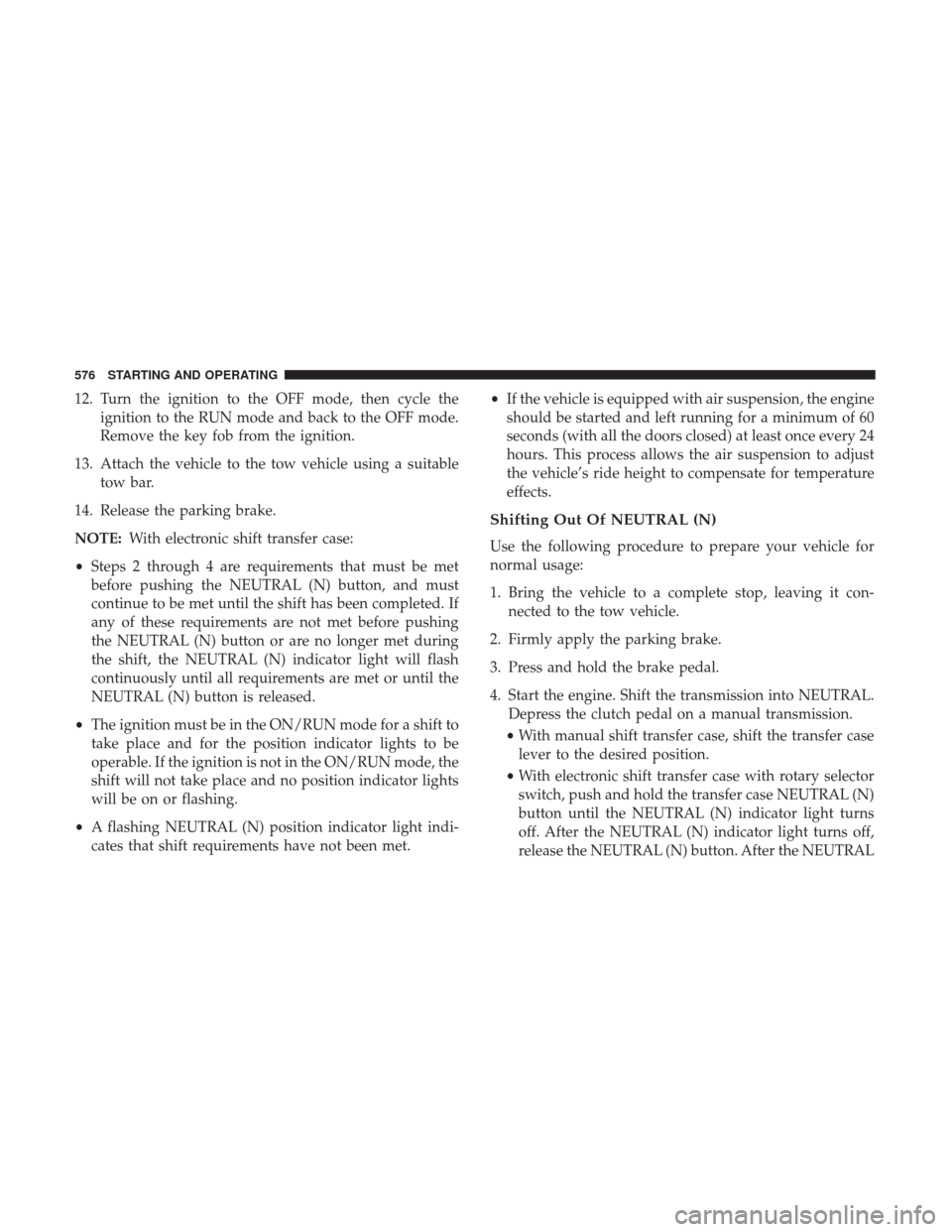
12. Turn the ignition to the OFF mode, then cycle theignition to the RUN mode and back to the OFF mode.
Remove the key fob from the ignition.
13. Attach the vehicle to the tow vehicle using a suitable tow bar.
14. Release the parking brake.
NOTE: With electronic shift transfer case:
• Steps 2 through 4 are requirements that must be met
before pushing the NEUTRAL (N) button, and must
continue to be met until the shift has been completed. If
any of these requirements are not met before pushing
the NEUTRAL (N) button or are no longer met during
the shift, the NEUTRAL (N) indicator light will flash
continuously until all requirements are met or until the
NEUTRAL (N) button is released.
• The ignition must be in the ON/RUN mode for a shift to
take place and for the position indicator lights to be
operable. If the ignition is not in the ON/RUN mode, the
shift will not take place and no position indicator lights
will be on or flashing.
• A flashing NEUTRAL (N) position indicator light indi-
cates that shift requirements have not been met. •
If the vehicle is equipped with air suspension, the engine
should be started and left running for a minimum of 60
seconds (with all the doors closed) at least once every 24
hours. This process allows the air suspension to adjust
the vehicle’s ride height to compensate for temperature
effects.
Shifting Out Of NEUTRAL (N)
Use the following procedure to prepare your vehicle for
normal usage:
1. Bring the vehicle to a complete stop, leaving it con- nected to the tow vehicle.
2. Firmly apply the parking brake.
3. Press and hold the brake pedal.
4. Start the engine. Shift the transmission into NEUTRAL. Depress the clutch pedal on a manual transmission.
• With manual shift transfer case, shift the transfer case
lever to the desired position.
• With electronic shift transfer case with rotary selector
switch, push and hold the transfer case NEUTRAL (N)
button until the NEUTRAL (N) indicator light turns
off. After the NEUTRAL (N) indicator light turns off,
release the NEUTRAL (N) button. After the NEUTRAL
576 STARTING AND OPERATING
Page 630 of 734
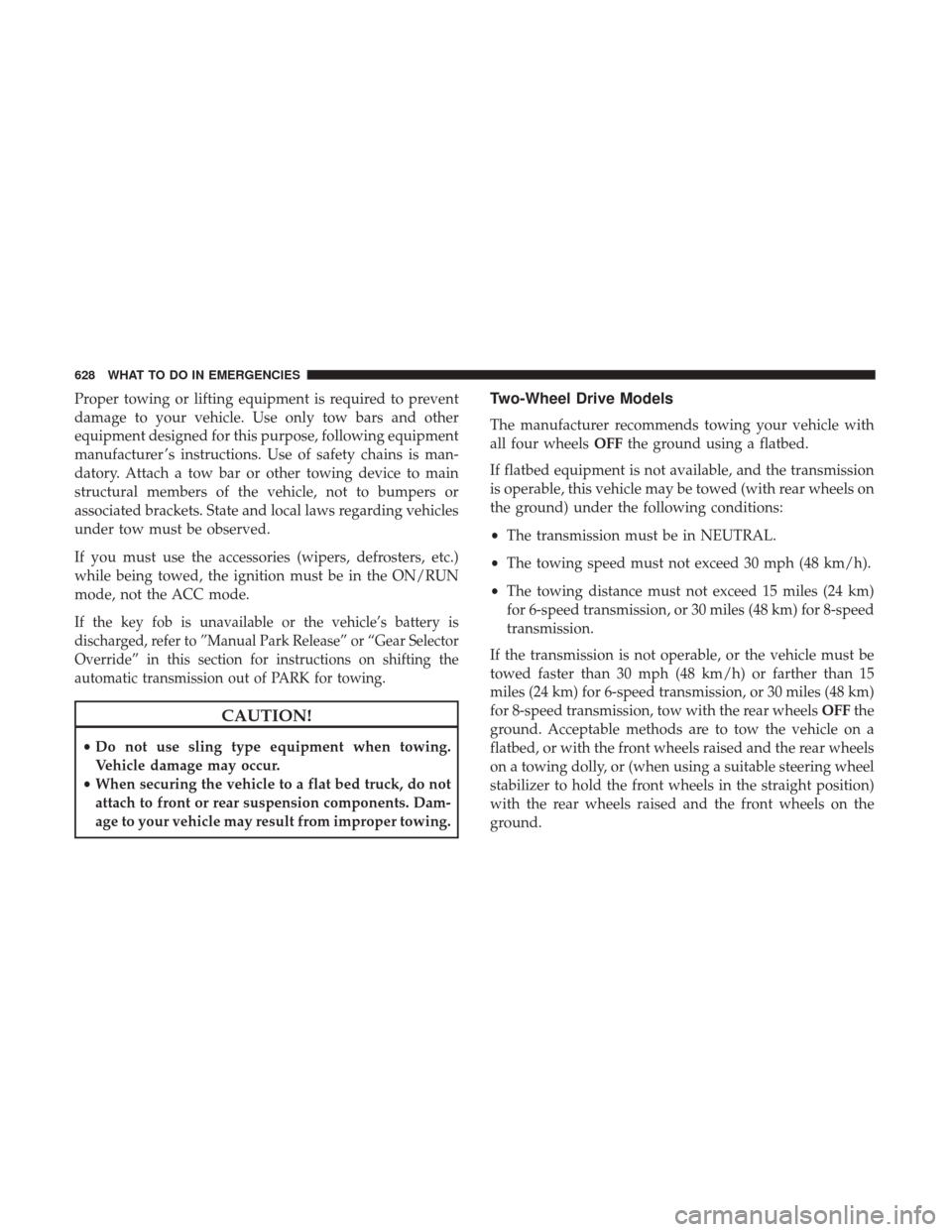
Proper towing or lifting equipment is required to prevent
damage to your vehicle. Use only tow bars and other
equipment designed for this purpose, following equipment
manufacturer ’s instructions. Use of safety chains is man-
datory. Attach a tow bar or other towing device to main
structural members of the vehicle, not to bumpers or
associated brackets. State and local laws regarding vehicles
under tow must be observed.
If you must use the accessories (wipers, defrosters, etc.)
while being towed, the ignition must be in the ON/RUN
mode, not the ACC mode.
If the key fob is unavailable or the vehicle’s battery is
discharged, refer to ”Manual Park Release” or “Gear Selector
Override” in this section for instructions on shifting the
automatic transmission out of PARK for towing.
CAUTION!
•Do not use sling type equipment when towing.
Vehicle damage may occur.
• When securing the vehicle to a flat bed truck, do not
attach to front or rear suspension components. Dam-
age to your vehicle may result from improper towing.
Two-Wheel Drive Models
The manufacturer recommends towing your vehicle with
all four wheels OFFthe ground using a flatbed.
If flatbed equipment is not available, and the transmission
is operable, this vehicle may be towed (with rear wheels on
the ground) under the following conditions:
• The transmission must be in NEUTRAL.
• The towing speed must not exceed 30 mph (48 km/h).
• The towing distance must not exceed 15 miles (24 km)
for 6-speed transmission, or 30 miles (48 km) for 8-speed
transmission.
If the transmission is not operable, or the vehicle must be
towed faster than 30 mph (48 km/h) or farther than 15
miles (24 km) for 6-speed transmission, or 30 miles (48 km)
for 8-speed transmission, tow with the rear wheels OFFthe
ground. Acceptable methods are to tow the vehicle on a
flatbed, or with the front wheels raised and the rear wheels
on a towing dolly, or (when using a suitable steering wheel
stabilizer to hold the front wheels in the straight position)
with the rear wheels raised and the front wheels on the
ground.
628 WHAT TO DO IN EMERGENCIES
Page 686 of 734
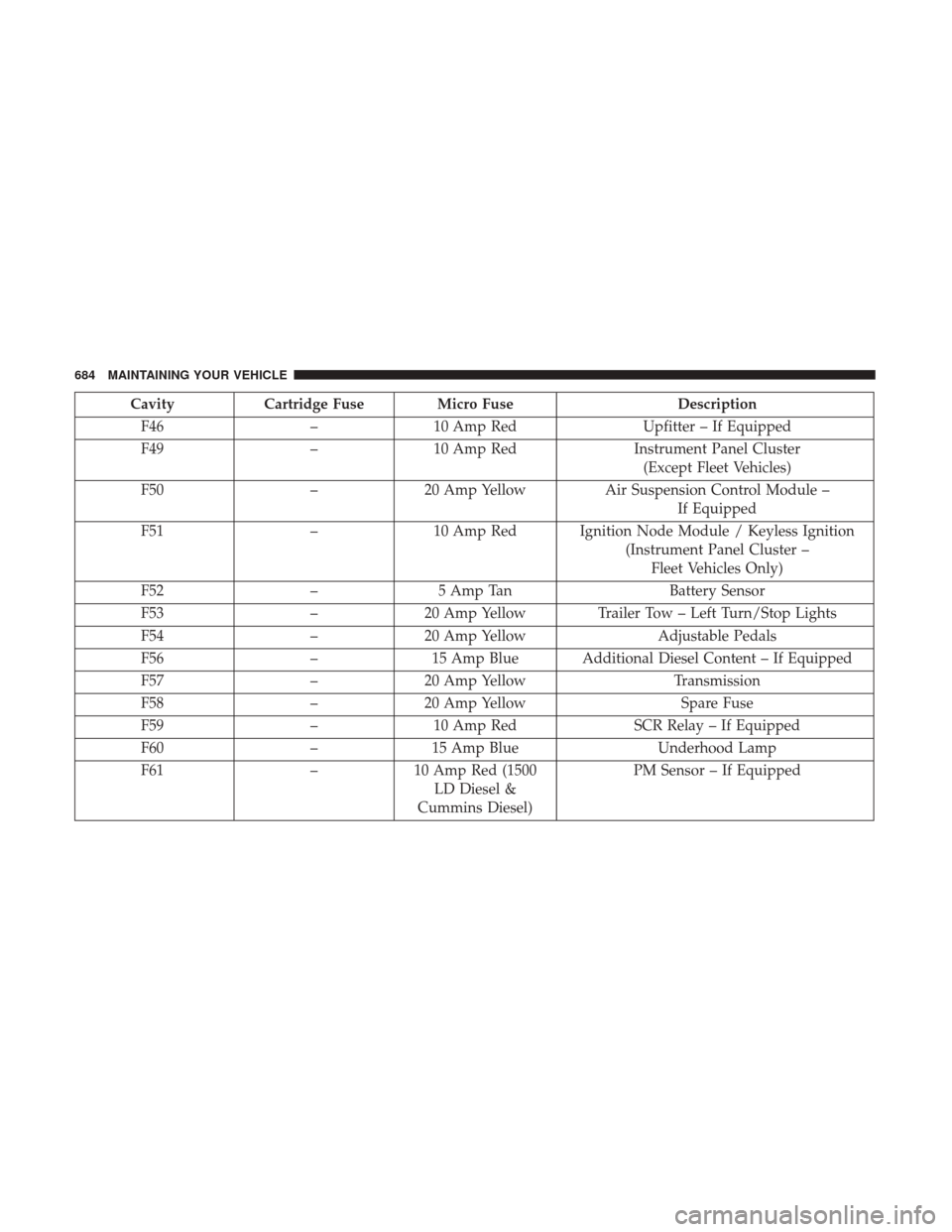
CavityCartridge Fuse Micro Fuse Description
F46 –10 Amp Red Upfitter – If Equipped
F49 –10 Amp Red Instrument Panel Cluster
(Except Fleet Vehicles)
F50 –20 Amp Yellow Air Suspension Control Module –
If Equipped
F51 –10 Amp Red Ignition Node Module / Keyless Ignition
(Instrument Panel Cluster –Fleet Vehicles Only)
F52 –5 Amp Tan Battery Sensor
F53 –20 Amp Yellow Trailer Tow – Left Turn/Stop Lights
F54 –20 Amp Yellow Adjustable Pedals
F56 –15 Amp Blue Additional Diesel Content – If Equipped
F57 –20 Amp Yellow Transmission
F58 –20 Amp Yellow Spare Fuse
F59 –10 Amp Red SCR Relay – If Equipped
F60 –15 Amp Blue Underhood Lamp
F61 –10 Amp Red (1500
LD Diesel &
Cummins Diesel) PM Sensor – If Equipped
684 MAINTAINING YOUR VEHICLE